In brief
- The EY 2021 Global Insurance Consumer Survey explored the financial anxiety caused by COVID-19, how consumers plan to respond and the protections they want now.
- The pandemic’s powerful financial and psychological effects were felt most intensely by younger consumers and in emerging markets.
- Given increased consumer interest, there is huge opportunity for insurers that develop accessible, purpose-led solutions and update distribution channels.
For consumers, the COVID-19 pandemic has been the equivalent of a massive life event. Its broad-based and multi-dimensional effects were felt psychologically, emotionally and economically. The profound financial impacts forced people around the world to reassess their priorities, goals and needs — indeed their entire lifestyles in some cases.
Widespread health concerns, pervasive economic uncertainties and strict lockdowns bound people around the world into a shared experience of unprecedented scale. But while anxiety and psychological effects were felt universally, it truly has been a tale of two pandemics, financially speaking.
Consumers in emerging markets were hit harder than those in mature economies, both in terms of their health and finances. They faced more severe consequences such as job loss, reduction in working schedules and the need to dip into savings. Younger generations were more heavily affected financially, while older citizens faced a greater mortality risk. Of course, many of these initial effects are still lingering as the virus persists.
Recent EY research confirms how the pandemic fundamentally changed consumer needs, how they plan to increase their financial security and what insurers can do to seize the opportunity. Between May and August 2021, EY surveyed 4,200 people in seven countries (Brazil, Canada, Japan, the Netherlands, the Philippines, South Africa and the U.S.) about the pandemic’s financial impacts, respondents’ plans going forward, their interest in different types of insurance products and their buying preferences (see full methodology). We also spoke to people in cities across the world to get their perspective.
The results of our research reveal consumers’ interest in new products, with strong value propositions and specific features, and an openness to interact and buy in new ways. Insurers will need to engage consumers with empathy, develop solutions that strengthen financial well-being, innovate their product sets and optimize digital distribution channels. Ultimately, insurers must live their purpose of providing protection to those who need it most, with an eye toward bridging the protection gap.
The four key findings from the EY 2021 Global Insurance Consumer Survey:
- The pandemic caused almost universal anxiety, which has prompted consumers to take action and increased their interest in new protections.
- Beyond the shared psychological impacts, emerging markets and younger generations took the biggest financial hit and show the greatest interest in new products.
- Emerging market consumers are digitally savvy, open to sharing data and ready to buy new products in new ways.
- Because corporate social responsibility matters to consumers, insurers need to stand behind great values as well as great products.
How consumers plan to respond to universal financial anxiety — Short-term protections are the priority.
The threats of the COVID-19 pandemic were felt quite close to home. Losing a loved one earlier than expected was the top concern for consumers worldwide, with 76% of overall respondents citing concern. Clearly, this was more than an economic crisis, though the financial stakes were high, too. Financial well-being was the second-highest concern, cited by 73% of all respondents.
Consumers around the world also have much in common in terms of their reaction to the pandemic. Three out of four (75%) anticipate making financial preparations in response to the pandemic. Specifically:
- 50% plan to save more
- 30% expect to develop emergency plans
- 23% plan to speak with a financial adviser
The implication is clear: Nobody wants to be caught out like this again. Recovery and preparation for another crisis are the immediate priorities, rather than retirement or estate planning.
Significant percentages of respondents are interested in new types of insurance products. They expressed the greatest interest in policies that pay for hospitalization expenses (94% in emerging markets and 64% in developed markets are interested), followed by an add-on feature for life insurance that allows access to funds in case of emergencies (91% in emerging markets and 56% in developed markets are interested). They are also thinking about short-term income protection products, like insurance that funds college education plans or pays for credit card bills in the case of a job loss.
Compared with a similar study EY conducted in mid-2020, these findings show a remarkable consistency. Despite the hopeful signs in the late spring and early summer of 2021, financial worries do not look likely to abate anytime soon. Consumers are keenly interested in avoiding what we call “long financial COVID-19,” a sustained state of financial anxiety due to overall uncertainty and a sense of not being prepared for another highly disruptive event.
See also: 3 Tips for Improving Customer Loyalty
The intense impact on emerging markets and younger consumers — Financial distress drives new demand.
Our survey results quantify the varying financial impacts across markets. Consumers in emerging markets felt more severe impacts, but consumers in developed markets were not unscathed. In fact, significant proportions of the latter group dipped into savings or lost income.
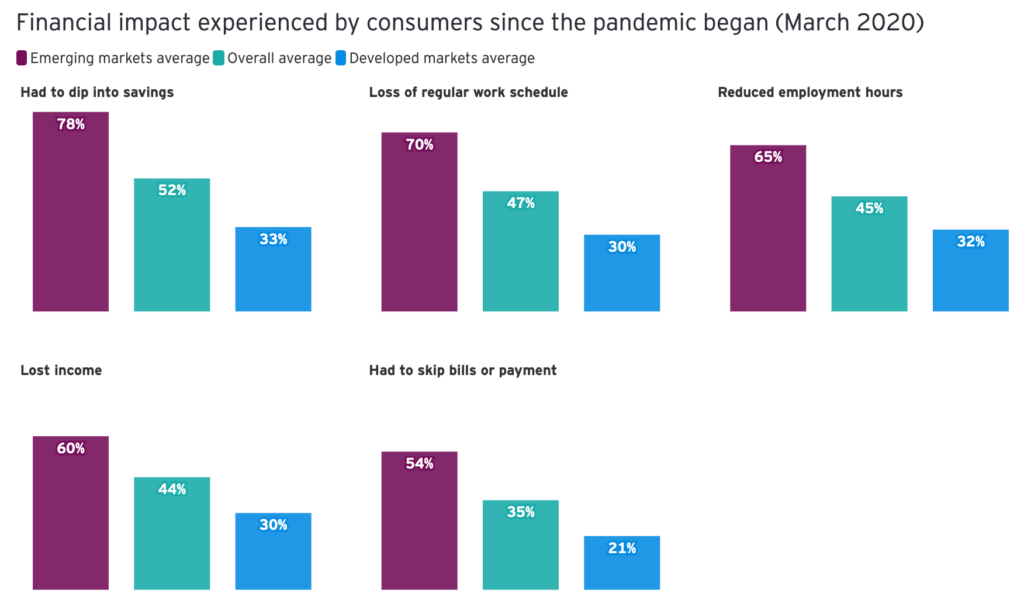
Interestingly, consumer responses to financial distress show the differences across markets: 93% of respondents in emerging markets plan to make at least some type of financial preparation, compared with 61% in developed markets. About one in four, or 23%, of consumers in emerging markets plan to purchase new forms of insurance, and nearly 42% plan to speak with their adviser about an emergency plan. The desire to prepare for future disruptions is surely prompting these actions.
It’s important to note how demographics correlate to these findings. Typically, emerging markets have younger populations, as reflected in our survey design. In emerging markets, 75% of the respondents were under the age of 45, compared with 35% in developed markets. Among our respondents, only 10% in emerging markets have more than $100,000 in investable assets, versus 37% for developed markets.
The varying levels of concern across different markets can also be attributed to the relative strength of healthcare systems, social safety nets and access to vaccinations. For instance, in emerging markets, where vaccination rates are considerably lower than in developed markets, concerns about losing a loved one and financial well-being were notably higher. That anxiety remains high more than a year after the onset of the pandemic speaks to the severity and extent of the psychological trauma.
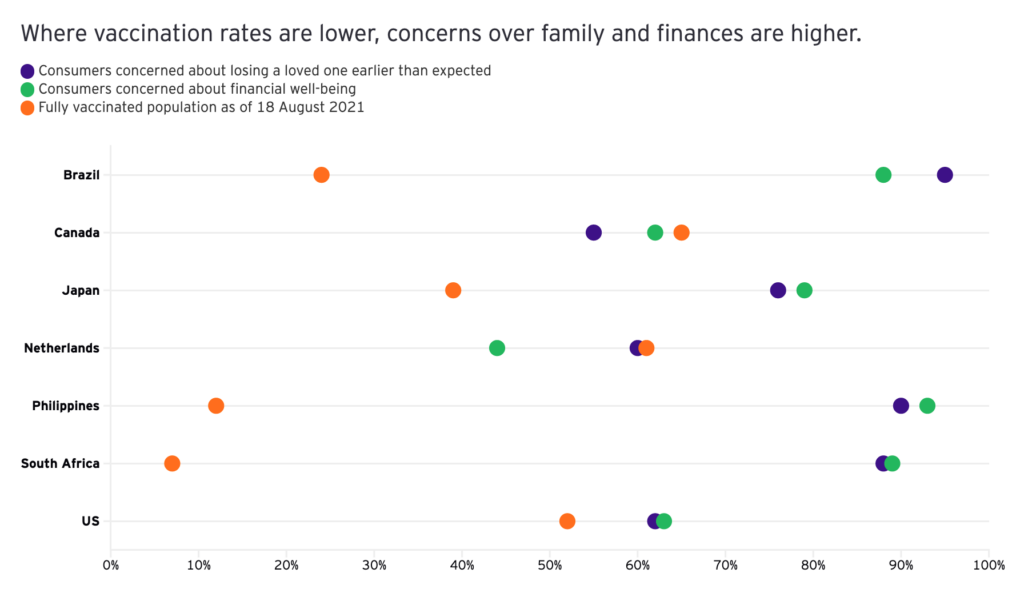
The word cloud below includes the most common comments from our survey respondents in emerging markets, demonstrating the diversity and intensity of their fears. Facing threats of economic instability, along with increased crime and delinquency, this population may require even more protection of their assets.
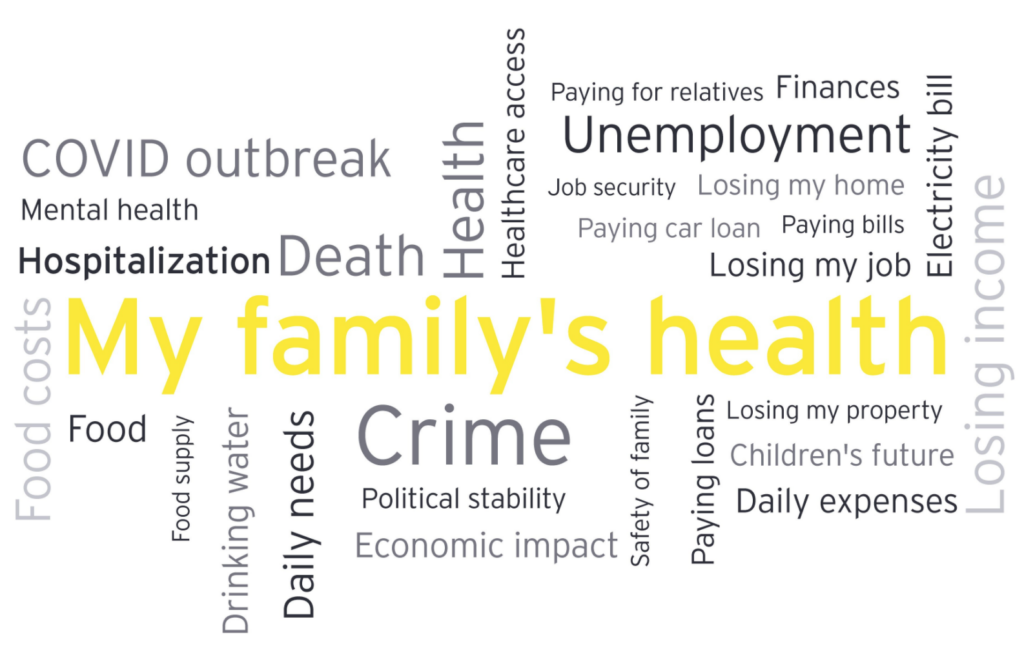
Our analysis of these findings confirms that there is a huge and largely underserved segment of the market that needs — and is ready to buy — new forms of protection. For example, 61% of respondents in emerging markets are interested in purchasing life insurance in response to the pandemic. Consumers in developed markets also want more life coverage, as evidenced by the significant uptick in sales and applications during the last year. Research and markets estimates global life insurance market growth at 16% from 2020 to 2021.
It’s no surprise that the greatest opportunity is with the consumers most affected by the pandemic, both in terms of health and finances. Historically, this has been a tough market to serve profitably. But insurers should view the scope of the growth potential in terms of greatly expanded and intensified consumer interest in their products. The opportunity to bridge the protection gap and build lifelong customer relationships has never been greater.
See also: Digital Solution for Income Protection
A new wave of digitally savvy consumers emerges — Desire for new solutions in new ways
In considering how to take advantage of the demand spike, insurers will of course consider the most cost-effective ways to serve consumers in emerging markets. In this sense, our survey presents good news in that this digitally savvy demographic vastly prefers online channels: 80% are likely to purchase health insurance, and 73% are likely to purchase life insurance digitally. Nearly 60% prefer contacting their agents or brokers digitally.
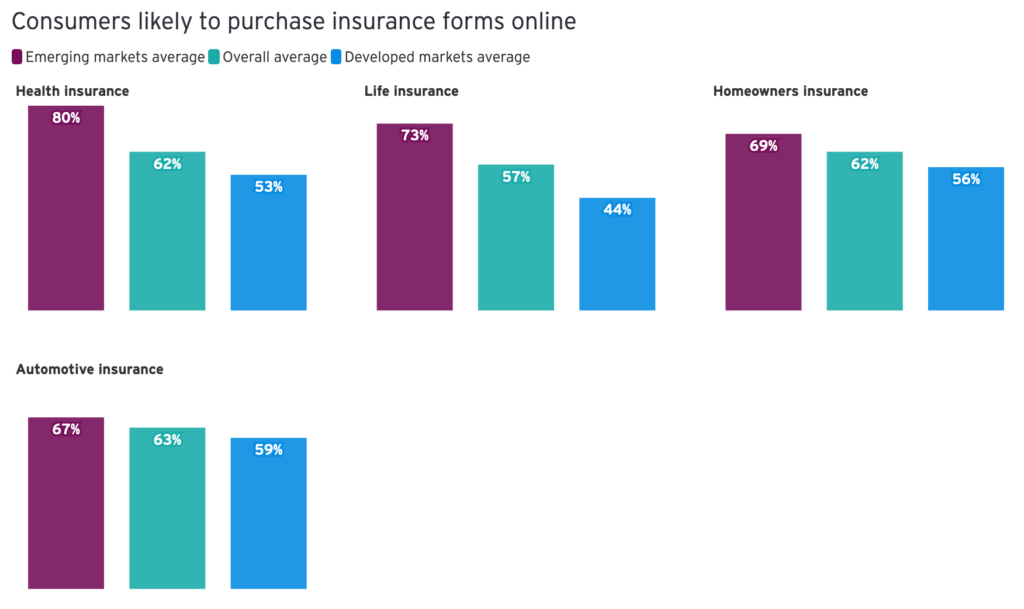
Further, they are ready to share more data, with more than half of emerging markets respondents willing to share personal information in exchange for meeting savings goals or individual health-related goals. They are also open to new buying options — 47% are comfortable purchasing an embedded insurance policy from a healthcare firm or hospital chain.
To connect with these consumers, insurers will need stronger digital capabilities, in addition to accessible and affordable products. Those are the necessary elements to satisfy these customers efficiently and prepare for potential competition from healthcare firms. Insurers will also need to communicate more effectively, demonstrating that they understand what consumers have been through and what they need now.
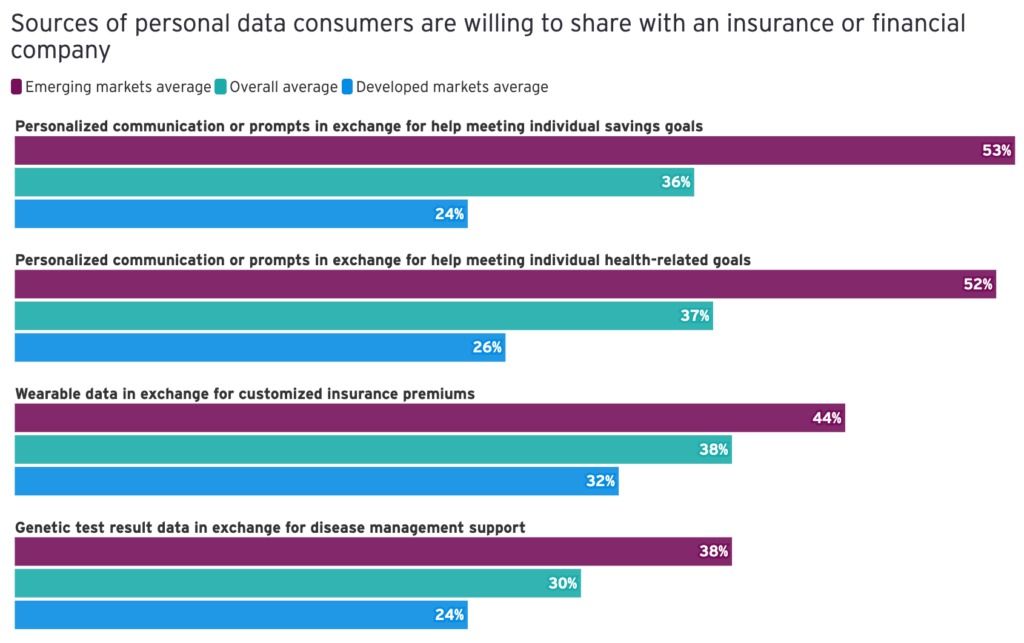
Some forward-looking insurers are already taking steps in this direction. One Asian carrier developed a new policy with clearly defined benefits — coverage for up to three months of expenses in the case of a pandemic-related hospitalization.
The offering was targeted at younger consumers, with whom the carrier had limited previous engagement. The business case was founded on a few strategic principles: that the firm’s network of advisers would gain access to new customers, that these relationships could be expanded and grown profitably and that the new offering aligned to the firm’s purpose of promoting financial security.
Our conversations with consumers highlight the demand for innovative products and distribution channels, along with strong customer relationships.
Why great values matter, along with great products — Social commitments count with consumers.
The pandemic, along with other events of the last year, advanced consumer interest in corporate social responsibility (CSR) and raised expectations about how companies contribute to society. A full 59% of consumers worldwide know their insurers’ CSR stance at least somewhat well, with consumers under the age of 45 more aware of social commitments. An average of 56% took at least some CSR-related action involving insurance or other financial products. Reputation is the most critical factor, with a quarter of respondents saying that they have chosen one insurance brand over another due to its CSR reputation.
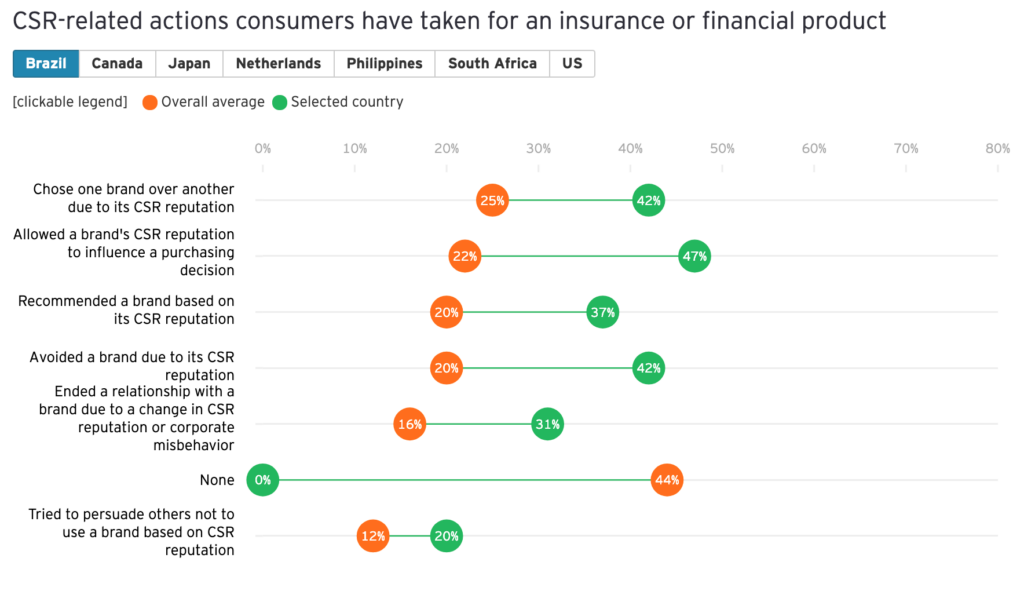
Consumers in emerging markets are more actively engaged around CSR than their counterparts in advanced economies: 73% say they are aware of the social responsibility stance of companies they do business with, versus 48% in developed markets.
These numbers are consistent with our 2020 consumer survey findings, where we found the most financially affected consumers are both highly concerned about social justice causes and place a greater value on an insurer’s social efforts in their purchasing decisions.
Other EY research supports these conclusions. The latest edition of the EY Future Consumer Index suggests 43% of global consumers want to buy more from organizations that benefit society, even if their products or services cost more. Nearly two-thirds, or 64%, are prepared to behave differently if it benefits society.
More and more, consumers are choosing brands that share their values, especially regarding urgent societal issues, including climate change, diversity and inclusion and income inequality. By articulating a purpose beyond profits and amplifying their CSR efforts, insurers can gain traction with a socially active, energized audience. That their products can directly improve financial well-being and facilitate the transition to a greener economy demonstrates how insurers are uniquely positioned to show leadership and differentiate on CSR.
See also: How to Use AI in Customer Service
What’s next for insurers: implications and takeaways
The powerful effects of the pandemic will be felt for a long time, at both the level of the global economy and within individual human lives. The lockdowns and social isolation; the fear of contracting the virus and of losing a loved one; the disruption of jobs, careers and everyday activities; the yearning for a return to normalcy and greater financial security — these are the universal truths of the COVID-19 era. Insurers can respond and help people recover in meaningful ways.
1. Communicate with empathy to build trust: Our research, along with other studies, provides a detailed understanding of the new challenges that consumers face, their interests in specific products and how they intend to prepare for future shocks. The first thing insurance companies need to do is show that they understand all the impacts — from financial to physical and mental health.
Next, carriers should connect to their customers on a human level, with warmth and empathy, acknowledging the trauma of the last year. Language matters, especially in the digital channels younger consumers prefer. A human touch is the prerequisite to building trust and becoming a partner in strengthening financial well-being.
2. Innovate around customer value: The huge demand for new protections and financial well-being solutions cannot be ignored after a decade of sluggish industry growth. It must be seized vigorously and creatively, with new solutions and distribution options closely aligned to consumer needs and preferences. The key is to provide relevant guidance and scalable solutions now that will help consumers navigate the pandemic’s lingering financial impact and restore their financial well-being.
3. Strategically engage younger consumers: Personalized communications and new solutions are not only for mass-affluent and high-net-worth consumers. The pandemic opened a door to connect with younger and underserved consumers, a segment that insurers have long struggled to engage. It’s a moment of truth to introduce these individuals to the value of insurance as a means to prepare for future financial shocks and as the basis for long-term financial security. By providing relevant solutions now, insurers can lay the foundation for lifelong relationships.
4. Demonstrate purpose and commitment: Many carriers showed their purpose in the immediate aftermath of the pandemic, offering premium discounts and holidays and supporting local communities. Going forward, all operations — starting with products, communications and customer interactions —must be infused with such purposeful commitment and humanity. By linking their products to their core values and purpose, insurers can demonstrate they are good corporate citizens sincerely invested in delivering the protections that individuals, communities and society need now.








